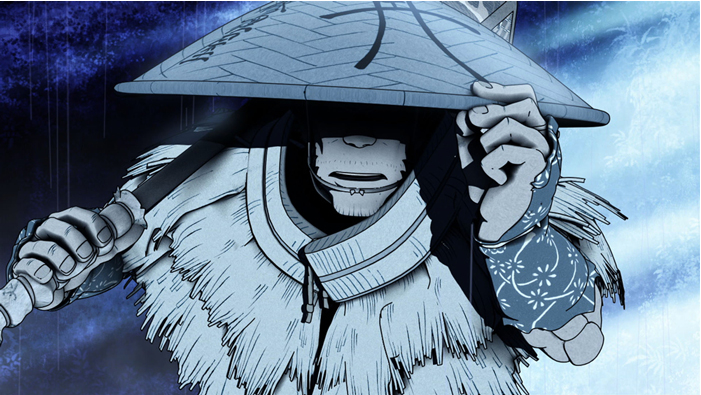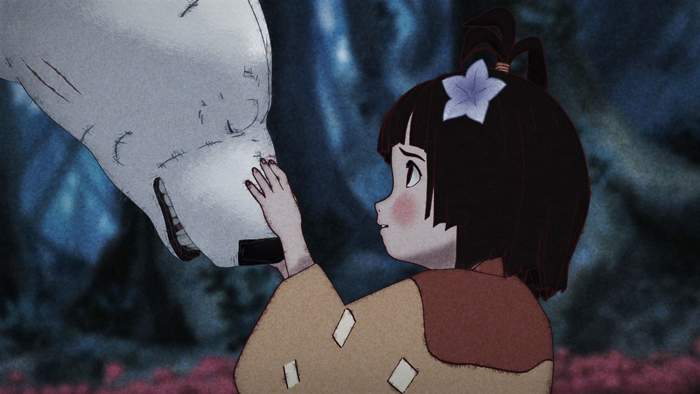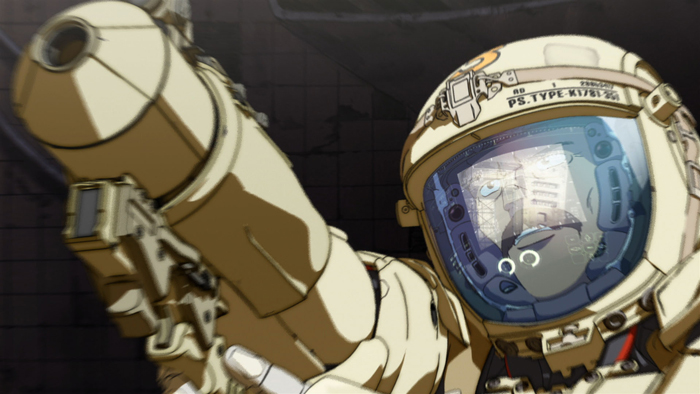Short Peace Review
With a variety of styles and a wealth of different kinds of stories, anime anthology films have always resonated with me. From their strengths in short form narratives, to the sense of style that a filmmaker can showcase, anime anthologies help to illustrate the power of the anime medium. One filmmaker that has always made it a point to help these films get made is Katsuhiro Otomo, creator of
Akira, whose contributed to films like
Robot Carnival,
Neo-Tokyo and
Memories. His latest contribution to this format is
Short Peace, an anthology film that rendered in CGI, to emulate a variety of styles, from traditional Japanese woodblock prints, to a futuristic Tokyo in ruins. Along with three other filmmakers, Otomo sets out to breathe new life into the format, which breaks some new ground, but some segments leave more to be desired.
“Possessions” follows a vagabond, who ends up in an abandoned shrine, which is home to various spirits that reside in household items. “Combustible” is Otomo's offering, in which a young woman who's in love with a childhood friend, causes a massive fire in her hometown. “Gambo” is about a giant white bear, who helps a young girl in despair, whose town is terrorized by an evil demon. The final short, “Farewell to Arms” is another short that Otomo writes, where a team of men who dig up old weapons, fight against a AI controlled tank, living in the ruins of Tokyo. Each of the shorts are around the 15 minute mark, which makes the film just over an hour.

Shuhei Morita, who directed “Possessions”, gets the film off to a very slow start. The same sense of style that Morita explored in Kakurebo, is presented here in a much more refined offering. The character of the Wanderer, presents some nice laughs and the backgrounds and animation presented in the piece are truly beautiful, but lack the depth and emotional core that some of the other films have to offer. I'm actually surprised that "Possessions" was the entry that was nominated for an Academy Award. Not that its terrible, but it could have done so much more with its beautiful aesthetic and setting, but doesn't break any new ground. Where things get extremely interesting is when “Combustible” begins, which is the only film that Otomo actually directs. With Otomo imitating the sense of woodblock prints, Short Peace begins to truly elevate and morphs itself into a beautiful work of art. Using camera pans and specific 3/4 angles, the short feels like these prints come to life. Once the actual fire is set and we head towards the conclusion of the film, the animators shift their focus into the chaos and ferocity that is a wild fire in ancient Japan.

“Gambo” is easily my favorite in Short Peace and possesses the most incredible use of CGI that I've ever seen in a Japanese animated film. There's a sort of watercolor technique that is employed in all of the elements, that makes it feel as though its a moving painting. Hiroaki Ando, who has worked on films like Tekkon Kinkreet and Otomo's Steamboy, brings an energy and a impeccable sense of style with his offering. The character designs by Yoshiyuki Sadamoto stand out, from his rendition of the giant bear, to the Christian samurai that's chasing him. The film was written by Katsuhiro Ishii, the writer of Redline, who sets a distinct tone, as well as a fully realized world that leaves one wanting so much more, from both the world and its intriguing characters that were shown.

“Gambo” is a perfect segue into the final film, “Farewell to Arms”, which presents itself as one major action action sequence. Written by Otomo and directed by classical Gundam designer, Hajime Katoki, the final film is a dazzling spectacle of warfare, that shows both Otomo's sense of scale, as well as Katoki's sense of mecha design and detail. While there are certain aspects that get ignored, like why the team is doing what they're doing or where they come from, but the basic premise of an evil AI tank against this squad of mercenaries is simple and straight forward.
Short Peace is one of the coolest anthologies to come out of Japan in a really long time. With its use of radical CGI techniques, variety in stories and display of both new and existing talent, there's enough to take away from it, that would please any anime fan.
Pros
- Unique use of CGI in Japanese animation
- Wealthy variety of stories to see
- New, young talent on display
Cons
- Possessions leaves a bit to be desired
- CGI might turn some people off
 Shuhei Morita, who directed “Possessions”, gets the film off to a very slow start. The same sense of style that Morita explored in Kakurebo, is presented here in a much more refined offering. The character of the Wanderer, presents some nice laughs and the backgrounds and animation presented in the piece are truly beautiful, but lack the depth and emotional core that some of the other films have to offer. I'm actually surprised that "Possessions" was the entry that was nominated for an Academy Award. Not that its terrible, but it could have done so much more with its beautiful aesthetic and setting, but doesn't break any new ground. Where things get extremely interesting is when “Combustible” begins, which is the only film that Otomo actually directs. With Otomo imitating the sense of woodblock prints, Short Peace begins to truly elevate and morphs itself into a beautiful work of art. Using camera pans and specific 3/4 angles, the short feels like these prints come to life. Once the actual fire is set and we head towards the conclusion of the film, the animators shift their focus into the chaos and ferocity that is a wild fire in ancient Japan.
Shuhei Morita, who directed “Possessions”, gets the film off to a very slow start. The same sense of style that Morita explored in Kakurebo, is presented here in a much more refined offering. The character of the Wanderer, presents some nice laughs and the backgrounds and animation presented in the piece are truly beautiful, but lack the depth and emotional core that some of the other films have to offer. I'm actually surprised that "Possessions" was the entry that was nominated for an Academy Award. Not that its terrible, but it could have done so much more with its beautiful aesthetic and setting, but doesn't break any new ground. Where things get extremely interesting is when “Combustible” begins, which is the only film that Otomo actually directs. With Otomo imitating the sense of woodblock prints, Short Peace begins to truly elevate and morphs itself into a beautiful work of art. Using camera pans and specific 3/4 angles, the short feels like these prints come to life. Once the actual fire is set and we head towards the conclusion of the film, the animators shift their focus into the chaos and ferocity that is a wild fire in ancient Japan.
 “Gambo” is easily my favorite in Short Peace and possesses the most incredible use of CGI that I've ever seen in a Japanese animated film. There's a sort of watercolor technique that is employed in all of the elements, that makes it feel as though its a moving painting. Hiroaki Ando, who has worked on films like Tekkon Kinkreet and Otomo's Steamboy, brings an energy and a impeccable sense of style with his offering. The character designs by Yoshiyuki Sadamoto stand out, from his rendition of the giant bear, to the Christian samurai that's chasing him. The film was written by Katsuhiro Ishii, the writer of Redline, who sets a distinct tone, as well as a fully realized world that leaves one wanting so much more, from both the world and its intriguing characters that were shown.
“Gambo” is easily my favorite in Short Peace and possesses the most incredible use of CGI that I've ever seen in a Japanese animated film. There's a sort of watercolor technique that is employed in all of the elements, that makes it feel as though its a moving painting. Hiroaki Ando, who has worked on films like Tekkon Kinkreet and Otomo's Steamboy, brings an energy and a impeccable sense of style with his offering. The character designs by Yoshiyuki Sadamoto stand out, from his rendition of the giant bear, to the Christian samurai that's chasing him. The film was written by Katsuhiro Ishii, the writer of Redline, who sets a distinct tone, as well as a fully realized world that leaves one wanting so much more, from both the world and its intriguing characters that were shown.
 “Gambo” is a perfect segue into the final film, “Farewell to Arms”, which presents itself as one major action action sequence. Written by Otomo and directed by classical Gundam designer, Hajime Katoki, the final film is a dazzling spectacle of warfare, that shows both Otomo's sense of scale, as well as Katoki's sense of mecha design and detail. While there are certain aspects that get ignored, like why the team is doing what they're doing or where they come from, but the basic premise of an evil AI tank against this squad of mercenaries is simple and straight forward.
Short Peace is one of the coolest anthologies to come out of Japan in a really long time. With its use of radical CGI techniques, variety in stories and display of both new and existing talent, there's enough to take away from it, that would please any anime fan.
“Gambo” is a perfect segue into the final film, “Farewell to Arms”, which presents itself as one major action action sequence. Written by Otomo and directed by classical Gundam designer, Hajime Katoki, the final film is a dazzling spectacle of warfare, that shows both Otomo's sense of scale, as well as Katoki's sense of mecha design and detail. While there are certain aspects that get ignored, like why the team is doing what they're doing or where they come from, but the basic premise of an evil AI tank against this squad of mercenaries is simple and straight forward.
Short Peace is one of the coolest anthologies to come out of Japan in a really long time. With its use of radical CGI techniques, variety in stories and display of both new and existing talent, there's enough to take away from it, that would please any anime fan.